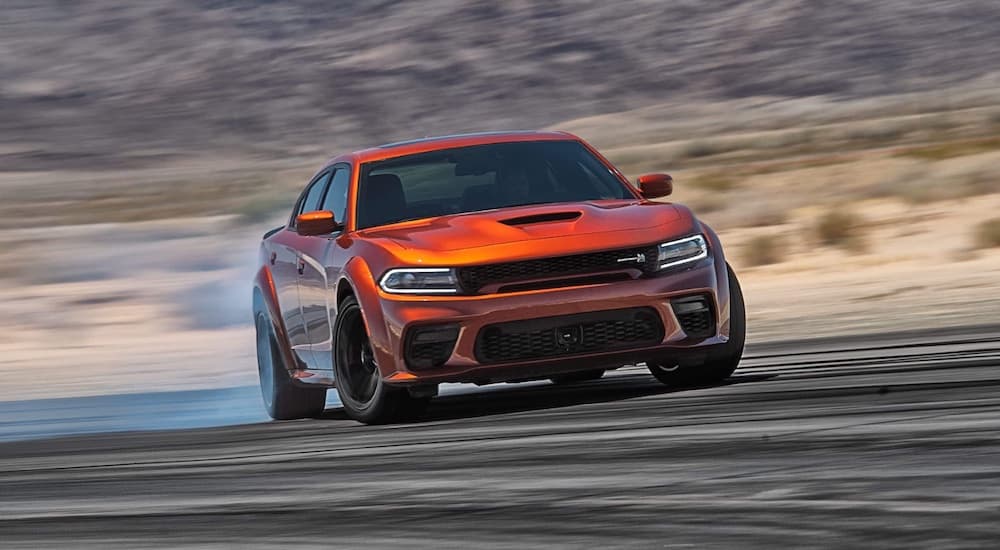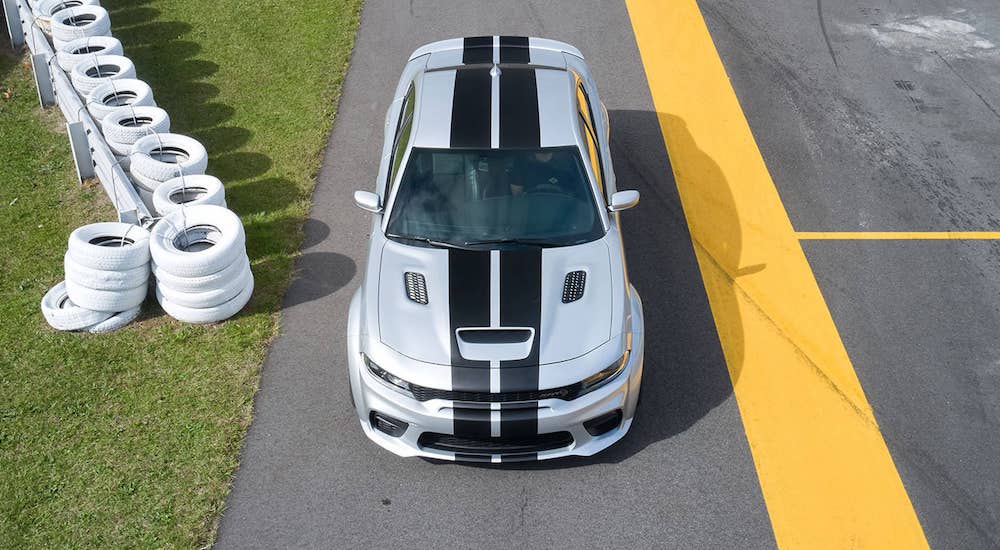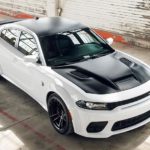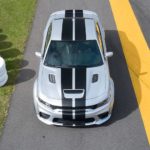If you’re browsing your local used Dodge dealer, you’re sure to turn up all sorts of intriguing options. Once known for its lineup of hardy trucks, Dodge has found a new niche in the last decade as the high-performance arm of the Stellantis automotive group. This new identity has given Dodge a chance to test its mettle against some of the biggest names in the performance sector, rolling out a steady stream of enthralling, sporty models that speak to Dodge’s evolution as a company. Now there are more changes afoot, with Dodge announcing plans to discontinue its two most iconic offerings, the Charger and Challenger, at the end of 2023.
The brand has promised that the names will live on in some other form, but we thought that we’d mark their departure by taking a closer look at these iconic muscle cars. While the last call might be here for new models, drivers will still be able to find used models for many years to come. From the earliest examples that emerged from the pony car wars of the 1960s to the final supercharged Hellcat models rolling off the line today, the Charger and Challenger have long been Dodge’s playground for high-speed experimentation. Let’s trace the history of these two renowned muscle cars and see how the recent models compare in some important categories, including size, trims, and engine offerings.
The Challenger: Dodge’s Pony Car
The Challenger didn’t start out as the legendary, rubber-burning pony car we know today. In fact, the first Challenger to roll off the assembly line was actually the 1959 Silver Challenger, a limited edition version of the brand’s popular Coronet full-size car. Sold exclusively with a striking silver paint job, the original Challenger was no slouch in the performance department with a 3.8-liter straight-six or 5.3-liter V8 to choose from, but it would pale in comparison to the next model to wear the Challenger badge.
The year was 1970, and pony cars were the talk of the town. Eager to compete in the rapidly expanding segment but knowing it needed to offer something new, Dodge introduced the Challenger as a high-end alternative to other popular pony cars like the Chevy Camaro and Ford Mustang. The Challenger featured a longer wheelbase, larger body, and more luxurious interior when compared to many of its rivals, but it was the pony car’s potent engine that set it apart from the crowd. The original 1970 Challenger came with a brawny 5.2-liter V8, but that was just the tip of the iceberg.
During the 1970s, the Challenger could also be optioned with virtually any engine from the Dodge lineup, ranging from a 3.2-liter I-6 to a 7.2-liter V8. The most common performance-minded model was the Challenger R/T, which packed a 6.3-liter Magnum V8 under the hood, providing the pony car with a monstrous 335 hp––an impressive figure given that the average vehicle in the 1970s only had around 100 hp. Dodge would continue to refine the Challenger formula over the decades, though the nameplate would be discontinued between 1983 and 2008 when the third-generation Challenger hit the streets.
The Charger: A Muscle Car Legend
The Challenger wasn’t Dodge’s first contender for the pony car crown. That would be the Dodge Charger, which debuted just two years after the Ford Mustang. Much like the Challenger that was to follow, the Charger was conceived as a larger, more luxurious alternative to the existing pony cars of the time. Dodge raided components from the popular Coronet to bring something entirely new to the market, introducing the 5.2-liter V8 Charger for the 1966 model year. The two-door coupe featured bucket seats for four, along with a full-length center console and swept fastback roofline that gave Dodge’s fledgling pony car a distinctive look.
Like the Challenger, the original Charger was offered with plenty of optional engines to choose from, from the base 5.2-liter V8 all the way up to a 7.0-liter HEMI V8 with 425 hp that made the Charger one of the most powerful vehicles of its day. Drivers and critics alike were won over by the Charger’s seductive HEMI, with MotorTrend penning a veritable love letter to the engine in its 1967 review. “The sound of the 425-hp HEMI when fired up is unmistakable,” wrote Bob Schilling. “It gives goose pimples to enthusiasts and fits to the competition. It isn’t really loud, just powerful and authoritative. Only the Shelby GT 350 and 500 offer a comparable sound.”
The Charger would really hit its stride in its second generation with a bold redesign that saw the pony car graced with alluring new curves, a vinyl-covered fastback roof, a sinister grille, and slick stowaway headlights. While the Charger was just as powerful as ever with a 7.0-liter HEMI and a 7.2-liter Magnum V8, a poor showing in the 1968 NASCAR season led Dodge to develop the Charger 500 in 1969. More aerodynamic than the original second-generation Charger, the Charger 500 would carve its name into racing history as it became the inspiration for the storied 1969 Charger Daytona. Dodge has since produced seven generations of the Charger with two brief pauses between 1979-81 and 1988-2005.
Debuting in 2006, the sixth generation would prove to be controversial as Dodge switched up the formula, transforming the Charger into a four-door sedan. While the redesign might have caught some longtime Charger fans off guard, Dodge never lost sight of the model’s powerful performance roots. The sixth-generation Charger came standard with a 2.7-liter V6 engine but, like its predecessors, put customization at the forefront. It was offered with a wide selection of engines, including 5.7-liter and 6.1-liter HEMI V8 options providing up to 425 hp.
Size and Design
The most obvious difference between the Charger and Challenger comes down to their size. This wasn’t always the case, as the Charger and Challenger were originally both two-door coupes, but that all changed with the Charger’s 2006 redesign following its nearly 20-year absence from the market. While both models can seat five passengers, the Charger is the roomier of the two, with improved cargo space and twice the number of doors as the Challenger.
The Charger has a longer body and wheelbase than the Challenger, allowing the four-door sedan to best the coupe when it comes to interior space. The Charger is easily the roomier ride, with a more spacious trunk when compared to the Challenger. The difference is even more pronounced when it comes to passenger volume, as the Charger boasts 105 cu.ft. to the Challenger’s 94 cu.ft. This makes the Charger the more practical choice for drivers who expect to regularly tote passengers around.
Modern Engine Options
While the Dodge Challenger and Charger might have changed a lot over the years, they’re still muscle cars that come complete with all the power and performance benefits that the title implies. The Charger has been offered exclusively with an eight-speed automatic transmission since 2015, while the Challenger continues to up the ante with an option manual transmission for its V8 engines. But beyond that, it’s hard to separate the two models. The more recent Challenger and Charger models offer an impressive lineup of five increasingly powerful engines, so let’s take a closer look.
The entry-level Challenger and Charger models are both equipped with a 3.6-liter V6 but differ slightly in terms of power. The sporty Challenger squeezes 303 hp out of the base engine, while the more practical Charger comes with 292 hp. As one might expect, the Challenger has the edge in terms of acceleration and top speed with a zero-to-60-mph time of 6.3 seconds to the Charger’s 6.4 seconds, though the Charger is available with a 3.6-liter engine rated for 300 hp that closes that gap a bit.
Moving up from the base engine, drivers can choose a 5.7-liter HEMI V8. Rated at 375 hp in the Challenger and 370 hp in the Charger, this engine offers a nice uptick in power without adding too much to the bottom line. Both the Challenger and Charger are also offered with a 6.4-liter HEMI V8 that produces 485 hp, but past that point, the Challenger is the real standout.
The Charger’s top engine offering is a supercharged 6.2-liter Hellcat V8 that churns out a massive 807 hp. While the Challenger is sold with the same engine, it has one more trick up its sleeve. The Challenger SRT Demon 170 is a true beast that produces a mind-blowing 1,025 hp on E85. Paired with factory 315-series drag tires, this engine is powerful enough to launch you from zero to 60 mph in just 1.66 seconds. It’s the type of figure that puts supercars to shame and makes the Challenger the clear favorite for those who prioritize speed above all else. Just don’t expect to find a used example up for grabs anytime soon.
The Last Call Isn’t Here Yet if You Shop Used
The Dodge Challenger and Charger will certainly be missed as the automaker ceases production after the current model year. These two models have long served as the perfect introduction to the world of high-performance driving, giving owners a chance to test their automotive mettle while remaining relatively affordable. However, used Charger and Challenger models will continue to provide exceptional value, allowing drivers to experience the sort of raw power that only a muscle car can offer without the price tag many drivers associate with such performance.
After 2023, the two muscle cars will be replaced by a two-door Charger that blends the best of both worlds with an all-electric drivetrain. While we’re excited to see the brand make a bid for the increasingly popular EV segment, there’s no replacing the sound and feel of a HEMI V8. Fortunately, the used market is full of intriguing pre-owned Chargers and Challengers to explore, with older examples putting even the highest trims and engine offerings well within reach of the average driver.






